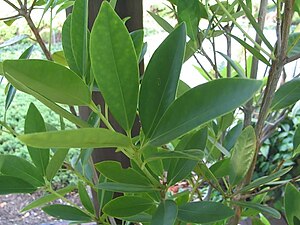Illicium verum/ja: Difference between revisions
Created page with "==特徴{{Anchor|Description}}== 葉は芳香があり、単葉で披針形、倒卵形から楕円形、または楕円形で、大きさは5–15 cm × 2–5 cm、革質から厚い革質である。葉は5–15 cm × 1.5–5 cmで、先端は鋭尖形、裏面には柔毛がある。花は単生、両性、ピンクから濃い赤色で、葉腋または亜頂生である。花被片は7–12枚でらせん状に配置され、雄しべは11–20..." |
Created page with "果実は袋果状の集合果で、星形、赤褐色であり、6個から8個の袋果が輪生している。各袋果は舟形をしており、長さは1–2 cm、粗く硬く、色は赤褐色で、種子が1個入っており、熟すと腹側縁に沿って開裂する。心皮の長さは10 mmで舟形であり、硬くしわがあり、種子を1個含む。種子は褐色、扁圧した卵形、滑らかで光沢があり脆く、おおよその大..." Tags: Mobile edit Mobile web edit |
||
| Line 39: | Line 39: | ||
葉は芳香があり、単葉で披針形、倒卵形から楕円形、または楕円形で、大きさは5–15 cm × 2–5 cm、革質から厚い革質である。葉は5–15 cm × 1.5–5 cmで、先端は鋭尖形、裏面には柔毛がある。花は単生、両性、ピンクから濃い赤色で、葉腋または亜頂生である。花被片は7–12枚でらせん状に配置され、雄しべは11–20本でらせん状に配置され、短く太い花糸を持つ。心皮は通常8個で離生し、単一の輪に配置される。花柄の大きさは1.5–4 cm、花被片は7–12枚で、広楕円形から広卵形、葯の大きさは1–1.5 mm、花粉粒は三合溝型である。 | 葉は芳香があり、単葉で披針形、倒卵形から楕円形、または楕円形で、大きさは5–15 cm × 2–5 cm、革質から厚い革質である。葉は5–15 cm × 1.5–5 cmで、先端は鋭尖形、裏面には柔毛がある。花は単生、両性、ピンクから濃い赤色で、葉腋または亜頂生である。花被片は7–12枚でらせん状に配置され、雄しべは11–20本でらせん状に配置され、短く太い花糸を持つ。心皮は通常8個で離生し、単一の輪に配置される。花柄の大きさは1.5–4 cm、花被片は7–12枚で、広楕円形から広卵形、葯の大きさは1–1.5 mm、花粉粒は三合溝型である。 | ||
果実は袋果状の集合果で、星形、赤褐色であり、6個から8個の袋果が輪生している。各袋果は舟形をしており、長さは1–2 cm、粗く硬く、色は赤褐色で、種子が1個入っており、熟すと腹側縁に沿って開裂する。心皮の長さは10 mmで舟形であり、硬くしわがあり、種子を1個含む。種子は褐色、扁圧した卵形、滑らかで光沢があり脆く、おおよその大きさは8–9 mm × 6 mmである。 | |||
<div lang="en" dir="ltr" class="mw-content-ltr"> | <div lang="en" dir="ltr" class="mw-content-ltr"> | ||
Revision as of 14:01, 16 June 2025
| Illicium verum/ja | |
|---|---|

| |
| トウシキミ(Illicium verum) がアメリカ国立樹木園にあるる | |

| |
| 八角の果実と種子 | |
| Scientific classification | |
| Kingdom: | Plantae |
| Clade: | Tracheophytes |
| Clade: | Angiosperms |
| Order: | Austrobaileyales |
| Family: | Schisandraceae |
| Genus: | Illicium |
| Species: | verum
|
| Binomial name | |
| verum | |
| Synonyms | |
| |
Wikの翻訳 カスタム Gem トウシキミ(Illicium verum)(八角、スターアニス、チャイニーズスターアニス、スターアニスシード)は、中国南部およびベトナム北東部原産の中型の常緑樹である。熟す直前に収穫される星形をしたその果皮は、アニスに風味がよく似たスパイスである。主な生産国は中国で、ベトナムや他の東南アジア諸国がそれに続く。八角油は非常に香りが高く、料理、香水、石鹸、歯磨き粉、うがい薬、スキンクリームなどに使用される。2012年に遺伝子組み換え大腸菌を使用するようになるまで、ロシュ・ファルマシューティカルズはシキミ酸を介してオセルタミビル(タミフル)を製造するために、世界の年間八角収穫量の最大90%を使用していた。
語源と命名法
| スターアニス | |||||||||||||||||||
|---|---|---|---|---|---|---|---|---|---|---|---|---|---|---|---|---|---|---|---|
| Chinese | 八角 | ||||||||||||||||||
| Literal meaning | "eight-horns" | ||||||||||||||||||
| |||||||||||||||||||
Illicium はラテン語のillicioに由来し、「誘惑する」または「魅惑する」を意味する。
Verumは「真の」または「本物の」を意味する。
「badian」という名称は、フランス語のbadianeを経由して、どうやら中国語の描写的な名称である八角(pinyin: bājiǎo、文字通り「八つの角」)に由来するようである。しかし、ペルシャ語のبادیان bādiyān、「フェンネル」からの派生も存在し、オックスフォード英語辞典は、それ以前の語源は不明であるとしている。
特徴
葉は芳香があり、単葉で披針形、倒卵形から楕円形、または楕円形で、大きさは5–15 cm × 2–5 cm、革質から厚い革質である。葉は5–15 cm × 1.5–5 cmで、先端は鋭尖形、裏面には柔毛がある。花は単生、両性、ピンクから濃い赤色で、葉腋または亜頂生である。花被片は7–12枚でらせん状に配置され、雄しべは11–20本でらせん状に配置され、短く太い花糸を持つ。心皮は通常8個で離生し、単一の輪に配置される。花柄の大きさは1.5–4 cm、花被片は7–12枚で、広楕円形から広卵形、葯の大きさは1–1.5 mm、花粉粒は三合溝型である。
果実は袋果状の集合果で、星形、赤褐色であり、6個から8個の袋果が輪生している。各袋果は舟形をしており、長さは1–2 cm、粗く硬く、色は赤褐色で、種子が1個入っており、熟すと腹側縁に沿って開裂する。心皮の長さは10 mmで舟形であり、硬くしわがあり、種子を1個含む。種子は褐色、扁圧した卵形、滑らかで光沢があり脆く、おおよその大きさは8–9 mm × 6 mmである。
Differences with similar taxa: Illicium anisatum had smaller fruits that does not form a regular star due to the abortion of some carpels. Also fruit follicles are not swollen in the middle and had a more pointed apex. Also usually had more than 8 follicles and the fruit has weaker odour. The seeds in Illicium anisatum are flat or almost spherical.
Use
Culinary use


Star anise contains anethole, the same compound that gives anise, an unrelated plant, its flavor. Star anise has come into use in the West as a less expensive substitute for anise in baking, as well as in liquor production, most distinctively in the production of the liqueur Galliano.Star anise enhances the flavor of meat.
It is used as a spice in preparation of biryani and masala chai in some parts of the Indian subcontinent. It is widely used in Chinese cuisine, and in Malay and Indonesian cuisines. It is widely grown for commercial use in China, India, and most other countries in Asia. Star anise is an ingredient of the traditional five-spice powder of Chinese cooking. It is also a major ingredient in the making of phở, a Vietnamese noodle soup.
It is also used in the French recipe of mulled wine, vin chaud (hot wine). If allowed to steep in coffee, it deepens and enriches the flavor. The pods can be used in this manner multiple times by the potful or cup, as the ease of extraction of the taste components increases with the permeation of hot water.
Drug precursor
Star anise is the major source of the chemical compound shikimic acid, a primary precursor in the pharmaceutical synthesis of the anti-influenza drug oseltamivir (Tamiflu). An industrial method for the production of shikimic acid using fermentation of E. coli bacteria was discovered in 2005, and applied in the 2009 swine flu pandemic to address Tamiflu shortages, eventually reversing price increases for star anise as a raw material of shikimic acid. As of 2018, fermentation of E. coli was the manufacturing process of choice to produce shikimic acid for synthesis of Tamiflu.
Illicium verum is not toxic. However, other related species are toxic.
Japanese star anise (Illicium anisatum), a similar tree, is highly toxic and inedible; in Japan, it has instead been burned as incense. Cases of illness, including "serious neurological effects, such as seizures", reported after using star anise tea may be a result of deliberate economically motivated adulteration with this species. Japanese star anise contains the neurotoxin anisatin, which also causes severe inflammation of the kidneys (nephritis), urinary tract, and digestive organs when ingested.
Swamp star anise Illicium parviflorum, a similar tree found in the southern United States, is highly toxic and should not be used for folk remedies or as a cooking ingredient.
ISO Standardization
- ISO 676:1995 – contains the information about the nomenclature of the variety and cultivars
Identification
- Refer to the 4th edition of the European Pharmacopoeia (1153)
Differentiation from other species
Joshi et al. have used fluorescent microscopy and gas chromatography to distinguish the species, while Lederer et al. employed thin layer chromatography with HPLC-MS/MS.
仕様
- ISO 11178:1995 – ドライフルーツの仕様
参照
| この記事は、クリエイティブ・コモンズ・表示・継承ライセンス3.0のもとで公表されたウィキペディアの項目Illicium verum(24 May 2025, at 09:49編集記事参照)を翻訳して二次利用しています。 |